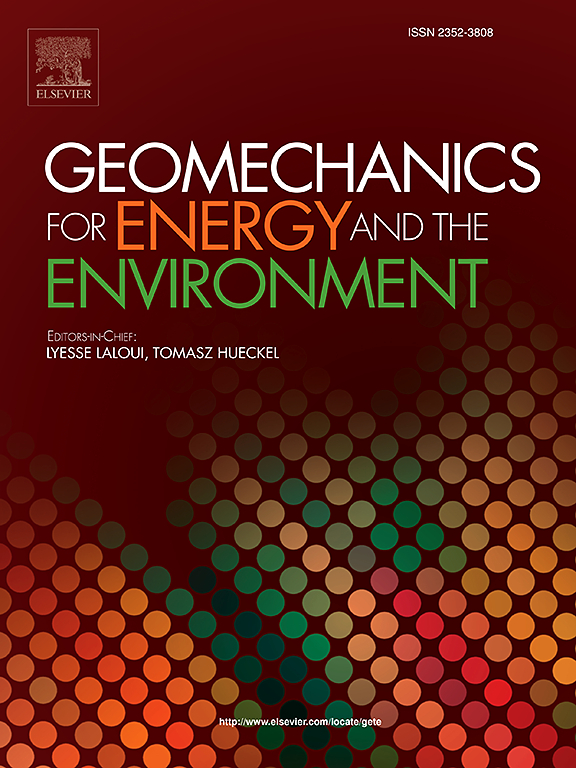砂岩在高温下的热力学响应和裂纹演变
IF 3.3
2区 工程技术
Q3 ENERGY & FUELS
引用次数: 0
摘要
了解岩石在高温下的热力学响应对于地下煤炭气化和地热系统等各种能源应用至关重要。该研究利用声发射单轴抗压强度、巴西抗拉强度和高温下的热重分析,研究了温度、矿物成分和晶粒大小对焦特布尔砂岩裂纹起始(CI)和裂纹损伤(CD)阈值的影响。研究发现,在温度处理条件下,裂纹起始应力阈值比(CISTR)和裂纹损伤应力阈值比(CDSTR)受矿物成分和晶粒大小的影响模式截然不同。铁锈色石英砺石的石英含量与裂纹起始/破坏应力阈值之间呈反比关系,而硅质石英砺石和钠长石则呈正比关系。已确定的差异归因于矿物之间不同的晶界强度。除石英和长石外,裂缝阈值与矿物的比较分析表明,裂缝阈值与粘土和其他矿物之间存在复杂的关系。细粒度砂岩的 CI 和 CISTR 与粘土含量成正比,而粗粒度砂岩则成反比。此外,研究还突出了韧性参数和 CISTR 的不同趋势,强调了晶粒大小和热处理条件在控制应力阈值方面的作用。在 500-600°C 的温度下,砂岩发生了显著的化学变化,包括石英相变和高岭石/黑云母脱羟基。铁闪闪石英褐铁矿中高岭石/红柱石的存在导致高岭石分解引起的纯氧气质量损失增加,而硅质石英褐铁矿在标准条件下的质量损失更大。研究结果表明,在热处理条件下,石英含量并不能持续提高岩石强度,尤其是在存在大量粘土矿物的情况下,这导致铁纹石英质 arenite 中的石英-岩石强度呈反比关系。该研究为了解砂岩的热力学行为提供了宝贵的见解,这对于评估能源应用中岩石的稳定性和耐久性至关重要。本文章由计算机程序翻译,如有差异,请以英文原文为准。
Thermomechanical response and crack evolution of sandstone at elevated temperatures
Understanding the thermomechanical response of rock at high temperatures is crucial for various energy applications such as underground coal gasification and geothermal systems. The study investigated the effects of temperature, mineral composition, and grain size on crack initiation (CI) and crack damage (CD) thresholds in Jodhpur sandstones using uniaxial compressive strength with acoustic emission, Brazilian tensile strength, and thermogravimetric analysis subjected to elevated temperatures. The study revealed distinct patterns in crack initiation stress threshold ratios (CISTR) and crack damage stress threshold ratios (CDSTR) influenced by mineral composition and grain size under temperature treatments. Ferruginous quartz arenite exhibited an inverse relationship between quartz content and crack initiation/damage stress thresholds, while siliceous quartz arenite and subarkose showed a positive correlation. The established variation is attributed to the differing grain boundary strengths among the minerals. Comparative analysis of crack thresholds with the minerals, excluding quartz and feldspar, revealed complex relationships with clay and other minerals. Finer-grained sandstones showed direct proportionality in CI and CISTR with clay content, while coarser sandstones exhibited an inverse relationship. Additionally, the study highlighted differential trends in toughness parameters and CISTR, emphasizing the role of grain size and heat-treatment conditions in governing stress thresholds. Significant chemical changes, including quartz phase shifts and kaolinite/muscovite dehydroxylation, occurred in sandstones at 500–600°C. The presence of kaolinite/hematite in ferruginous quartz arenite caused the increased mass loss in pure O2 due to kaolinite breakdown, while siliceous quartz arenite exhibited a greater mass loss in standard conditions. The findings suggest that quartz content does not consistently enhance rock strength under heat treatment, particularly in the presence of significant clay minerals, leading to an inverse quartz-rock strength relationship in ferruginous quartz arenites. The study provides valuable insights into the thermomechanical behavior of sandstones, which is crucial for assessing rock stability and durability in energy applications.
求助全文
通过发布文献求助,成功后即可免费获取论文全文。
去求助
来源期刊

Geomechanics for Energy and the Environment
Earth and Planetary Sciences-Geotechnical Engineering and Engineering Geology
CiteScore
5.90
自引率
11.80%
发文量
87
期刊介绍:
The aim of the Journal is to publish research results of the highest quality and of lasting importance on the subject of geomechanics, with the focus on applications to geological energy production and storage, and the interaction of soils and rocks with the natural and engineered environment. Special attention is given to concepts and developments of new energy geotechnologies that comprise intrinsic mechanisms protecting the environment against a potential engineering induced damage, hence warranting sustainable usage of energy resources.
The scope of the journal is broad, including fundamental concepts in geomechanics and mechanics of porous media, the experiments and analysis of novel phenomena and applications. Of special interest are issues resulting from coupling of particular physics, chemistry and biology of external forcings, as well as of pore fluid/gas and minerals to the solid mechanics of the medium skeleton and pore fluid mechanics. The multi-scale and inter-scale interactions between the phenomena and the behavior representations are also of particular interest. Contributions to general theoretical approach to these issues, but of potential reference to geomechanics in its context of energy and the environment are also most welcome.
 求助内容:
求助内容: 应助结果提醒方式:
应助结果提醒方式:


